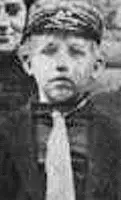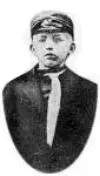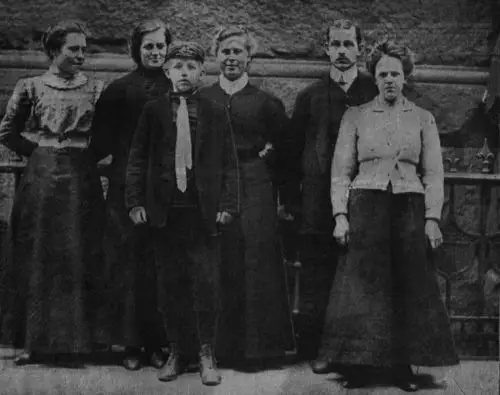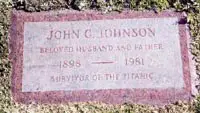Johan Cervin Svensson
Third Class Passenger

He saw a man, whom he thought to be one of the officers, shoot himself. "He put his gun right in his mouth and shot.”
Johan Cervin Svensson, sometimes also known as "Cervin Swenson" and who later changed his name to "John C. Johnson" was a 14 year old boy from Knäred, Halland, Sweden, born on March 5, 1898, the son of Sven Peter Johansson and Elisabeth Jönsdotter. (8.) The oldest son of seven children, he boarded Titanic at Southampton, having taken the train from Knäred to Gothenburg, Sweden, then a small boat to Hull, England. He was travelling to join his father Sven and sister Jenny who had moved to Alcester, Beresford, South Dakota, USA in 1911. The remainder of the family (sister Anna, and brothers Johan Rudolf, Leonard, Reinhold, and Gösta) planned to follow.
According to Encyclopedia Titanica "when Johan was ready to go his mother sewed 15 Kr into his jacket lining as spare cash." (8.) The Swanson family genealogical website adds that "as the ship was sinking on that fateful night, he was awakened by a knock on the door of the cabin that he shared with three other Swedes. Everyone was yelling, but he didn't understand English. Once he saw everyone donning lifejackets, he supposed he had better get one on, too. He jumped 10 or 20 feet down into on Lifeboat Number 13 at approximately 2:10 a.m. The Titanic fully sank about 10 minutes later. Lifeboat 13 arrived at the rescuing ship Carpathia in the early morning of April 15, 1912." (Johan Cervin Svensson - Titanic Survivor from Knäred, Sweden.)

Johan Cervin
Svensson
Encyclopedia Titanica says that "he later recalled that when the Titanic was sinking he sneaked onto the first class boat deck and after being refused twice finally got into lifeboat 13, the third boat he tried to enter. On board the Carpathia he was at first thought to be a first class passenger but looking upon his clothes it was realized that was not possible and he was sent down to join the other steerage passengers. In New York he was met by his uncle Isak Johnson." (8.)
A "Cervin Swenson" is mentioned on the United States Senate Inquiry Third-Class Passengers list (142. Swenson, Cervin). While traveling to Alcester, Beresford, South Dakota he apparently stopped at Hawarden, a small town on the border of South Dakota and Iowa, where he stayed at the firm of Johnson Cooper and through an interpreter gave the following account to The Courier (The Freeman Courier, Freeman, South Dakota) on May 2, 1912 under the name of Cervin Swenson:
Witness of 14 Tells Of Titanic Tragedy And His Own Escape
Lone Traveler from Sweden Describes Events in Ship's Dying Moments
Hawarden, Ia.---April 29---
One of the survivors of the Titanic, a boy 14 years old, arrived in Hawarden yesterday on his way to Alcester, S.D. where his father is. The boy, whose name is Cervin Swenson, traveled (sic) from Sweden, where he left his mother and five of her children entirely alone. A comrade, several years older, had meant to accompany him but decided to travel on a Scandenavian (sic) boat. The boy, who does not speak a word of English was entertained last night at the firm of Johnson Cooper, of this place, and through Mr. Johnson an interesting story is given of the young traveler's (sic) experiences.
Sailors Joke of Accident
Cervin was a third cabin passenger and was asleep in his bunk at the time of the collision. He and three men who shared his compartment were aroused by the sailors, who, however, talked jokingly of the accident, saying that they had stuck o na (sic) sandbar. Cervin went up on deck where many passengers were standing about with life belts on. The sailors made fun of them for wearing them. There was not much confusion or excitement, but the officers began to fill the life boats, people crowded up and they were handled very roughly by the officials, as they had to do to keep any discipline. Cervin himself tried repeatedly to get into a boat but again and again was crowded back. The deck was covered with handbags, suit cases and all sorts of light baggage which passengers had meant to take with them in the boats but they were not allowed to do so.
Finally the boy managed to get into a boat and was allowed to stay. There were 50 persons in this boat, mostly women and children. They were all very quiet, even when the ship sank, which they plainly saw, being as the boy put it "just about a kilometer away when it went down." A kilometer is five-eights of a mile.
Men Shoot Themselves
He declares that he saw a man, whom he thought to be one of the officers, shoot himself. "He put his gun right in his mouth and shot." He also says there was considerable shooting on deck. After they were in the boat they heard many shots. The three men who had been his roommates, he never saw again, but in his lifeboat was a young Swedish woman---the only one in the boat to whom he could talk. She had been married but two months. Her husband was also a passenger and was drowned. After about six hours in the life boat they were taken on the Carpathia. All had been very still till then, but as the ship approached, the women screamed and cried and "went crazy" as Cervin put it. They did not seem to know what they were doing and many of them had to be taken aboard the ship by force. In the other boats, they were the same way. On the Carpathia he was put in the steerage with "dagoes and Chinese" and thought he had pretty poor quarters, though thankful for any.
Treatment in New York
On reaching New York he was tken to the Swedish Lutheran Emigrant home which is in charge of Rev. Lilja, a prominent minister of that denomination. Here he staid (sic or archaic) while in New York. He was given two suitcases full of clothing, an overcoat and $25 in cash by the relief committee. He tells of countless kindnesses that he had received in New York and on his way here and says he thinks this the greatest country and the Americans the kindest people in the world.
The boy is described as an unusually shrewd, bright lad, and to this he doubtless owes his life, as he was among the saved entirely by his own efforts. He left by the early train for Alcester near which place his father is working on a farm.
Cervin Swenson escaped in Lifeboat No. 12. The Swedish woman who spoke with him was Anna Sjoblom. (The Courier -The Freeman Courier, Freeman, South Dakota- May 2, 1912)
Another version of Svensson's account appeared on the same day in The Independent, Hawarden, Iowa (May 2, 1912):
He estimated that they were only about a kilometer from the Titanic when she sank and could witness the scene on deck very plainly. He could see many of the passengers jumping overboard and heard considerable shooting on deck. He declares he thought he saw one of the officers shoot himself. The boat he was in did not go to the rescue of the people struggling in the water as it would not have accomodated more than four or five more people and they did not dare risk swamping the boat as they most certainly would have done had they made the attempt to rescue the drowning ones.
There is also a shorter newspaper article, according to Wendy Pearson, that references the suicide and shooting on May 10, 1912:
A Scandinavian boy fourteen years old named Cervin Swenson passed through Laurens (Iowa) last Friday on his way to join friends at Alcestor, South Dakota. He was one of the survivors from the Titanic and says that he saw one of the officers shoot himself and that there was considerable shooting on the boat before and after he left it. (May 10, 1912)
What can we say about Svensson's account? There is nothing that sounds sensational or exaggerated in his story. The article itself describes him as an "unusually shrewd, bright lad". Since he was in lifeboat no. 13, which also contained suicide witness Washington Dodge, we may wonder how much he could see of Titanic and any shooting or suicide. But he does mention that "when the ship sank, which they plainly saw, being as the boy put it "just about a kilometer away when it went down."

Johan Cervin Svensson 3rd from the left, pictured along with another Swedish immigrant, Anna Nysten, on the far right. (Photo: ET/Günter Bäbler)
According to the article the "Swedish woman who spoke with him was Anna Sjoblom." However Sjoblom, another suicide witness, is from the neighbouring country of Finland. So the other Swedish woman he mentions could be Anna Sofia Nysten or Agnes Charlotta Sandström (née Bengtsson) who was in lifeboat 13 with her two young daughters aged 1 and 4. He is pictured in a photograph with Anna Nysten so it is most likely her.
Curiously, it is said that the boy spoke no English, which could well be evidence in favour of his account as unlike other suicide witnesses his story would not necessarily be cross-pollinated by other survivors. However two other suicide witnesses are Swedish and may well have spoken to him: Oscar Johansson Olsson and Carl Olof Jansson. Carl Jansson's is similar in that he also mentions the officer placing a revolver in his mouth and shoot himself. (refer to Oscar Johansson Olsson, Carl Olof Jansson)
It is also interesting to note that at aged 14 he is the youngest of all the suicide witnessses. Dr Kemp's was apparently told an account of Captain Smith's suicide by "a boy and one of the last of the children to be taken from the Titanic". However we would need to either discover that Kemp could speak Swedish or that the boy's English was sufficient to communicate such information.

Svensson's grave
Once he arrived in Alcester, South Dakota his name was anglicized to John C. Johnson and also became known as "Titanic" Johnson. The family website mentions that "Johan's daughter, Joy Johnson said that her father always wondered "Why was I saved when so many others were lost?" and suffered nightmares for the remainder of his life." (Johan Cervin Svensson - Titanic Survivor from Knäred, Sweden.)
He later moved to California , married Hazel G. (Lindley) worked as a ship welder for a marine construction company based in the Long Beach harbor, not far from the Queen Mary. He died on 4th July, 1981 in Long Beach, California and his grave, along with that of his wife is in the Hazel Rose Hills cemetery near Whittier, California
(Thanks to George Jacub for this account)
Verdict: